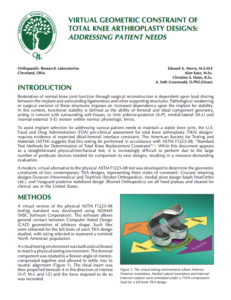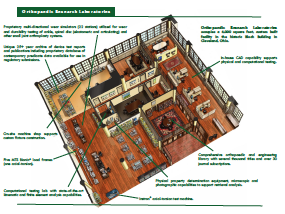 Restoration of normal knee joint function through surgical reconstruction is dependent upon load sharing between the implant and surrounding ligamentous and other supporting structures. Pathological weakening or surgical excision of these structures imposes an increased dependency upon the implant for stability. In this context, functional stability is defined as the ability of femoral and tibial component geometry, acting in concert with surrounding soft tissues, to limit anterior-posterior (A-P), medial-lateral (M-L) and internal-external (I-E) motion within normal physiologic limits. To assist implant selection for addressing various patient needs to maintain a stable knee joint, the U.S. Food and Drug Administration (FDA) pre-clinical assessment for total knee arthroplasty (TKA) designs requires evidence of expected tibial-femoral interface constraint. The American Society for Testing and Materials (ASTM) suggests that this testing be performed in accordance with ASTM F1223-08, “Standard Test Methods for Determination of Total Knee Replacement Constraint”. While this document appears as a straightforward physical/mechanical test, it is increasingly difficult to perform due to the large number of predicate devices needed for comparison to new designs, resulting in a resource-demanding evaluation. A modern, virtual alternative to the physical ASTM F1223-08 test was developed to determine the geometric constraints of four contemporary TKA designs, representing three styles of constraint.
Restoration of normal knee joint function through surgical reconstruction is dependent upon load sharing between the implant and surrounding ligamentous and other supporting structures. Pathological weakening or surgical excision of these structures imposes an increased dependency upon the implant for stability. In this context, functional stability is defined as the ability of femoral and tibial component geometry, acting in concert with surrounding soft tissues, to limit anterior-posterior (A-P), medial-lateral (M-L) and internal-external (I-E) motion within normal physiologic limits. To assist implant selection for addressing various patient needs to maintain a stable knee joint, the U.S. Food and Drug Administration (FDA) pre-clinical assessment for total knee arthroplasty (TKA) designs requires evidence of expected tibial-femoral interface constraint. The American Society for Testing and Materials (ASTM) suggests that this testing be performed in accordance with ASTM F1223-08, “Standard Test Methods for Determination of Total Knee Replacement Constraint”. While this document appears as a straightforward physical/mechanical test, it is increasingly difficult to perform due to the large number of predicate devices needed for comparison to new designs, resulting in a resource-demanding evaluation. A modern, virtual alternative to the physical ASTM F1223-08 test was developed to determine the geometric constraints of four contemporary TKA designs, representing three styles of constraint.
Virtual Geometric Constraint of Total Knee Arthroplasty Designs: Addressing Patient Needs
Apr 7, 2016 | Knee

